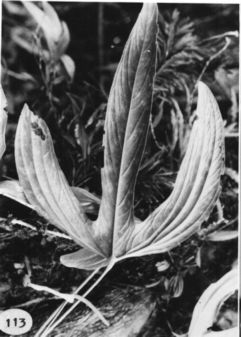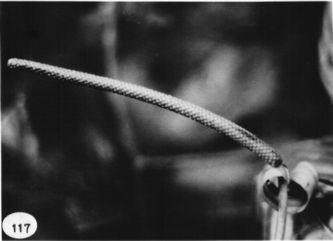





Anthurium madisonianum Croat, sp. nov.
TYPE: Panama. Chiriquí: along road from Gualaca to Fortuna Dam site, 5.9 mi. NW of Los Planes de Homito, 1,370 m, 82°12'W, 8°43'N, Croat 49883 (MO 2769028-29, holotype; PMA, US, isotypes; Live at MO).
Planta epiphytica; cataphyllum modice membranaceum, persistens in fibris grossis; petiolus plerumque teres, (15-)36-47(-70) cm longus; lamina subcoriacca, profunde trilobata, lateralis lobis interdum falcatis, plerumque ad angulum rectum a lobo mediano, 25-60 cm longa, 26-56 cm lata; inflorescentia effusa; pe-dunculus 24-52 cm longus; spatha viridis interdum subtusa rubro-violacea, lanceolata, 10-20 cm longa, 2-2.8 cm lata; stipite 1 cm longo; spadix rubro-violaceus, 9-20 cm longus; baccae subglobosae, albae aul albae apice suffuso rubro, 3-3.5 mm longae.
Epiphyte; stems green, ca. 20 cm long, ca. 3.5 cm diam.; leaf scars 2-2.5 cm wide; roots moderately thin, smooth, descending; cataphylls moderately thin, 6-9 cm long, drying brown (B & K Yellow 3/7.5), weathering to coarse fibers and persisting.
LEAVES spreading; petioles usually terete, (15-)36-47(-70) cm long, 4-8 mm diam.; geniculum 1-2 cm long; blades subcoriaceous, deeply 3-lobed, the lateral lobes falcate in larger blades, at a more or less right angle to median lobe in younger leaves; 25-60 cm long, 26-56 cm wide, the median lobe 25-60 cm long, 4-11 cm wide midway, lateral lobes 12.5-46.5 cm long, 3-12 cm wide at widest point; upper surface semiglossy, lower surface matte and paler than upper surface; midrib acutely raised above, sunken toward apex, convexly raised at base below, more acute toward apex; basal veins 3-6 pairs, the first sometimes free, usually coalesced 1-4 cm, those remaining coalesced 4.5-15 cm, forming a thick posterior rib; primary lateral veins 4-5 per side, departing midrib at 25-35° angle, sunken above, raised below, straight to collective vein, lesser veins scarcely visible, more conspicuous on drying; collective vein of median lobe arising from first basal vein or from one of the lowermost primary lateral veins, sunken above, raised below, 2-3 mm from margin.
INFLORESCENCE spreading, shorter than leaves; peduncle 24-52 cm long, 2-6 cm diam.; spathe green, sometimes tinged red-violet, lanceolate, 10-20 cm long, 2-2.8 cm wide, acuminate at apex, acute at base; stipe to 1 cm long; spadix red-violet, narrowly tapered toward apex, 9-20 cm long, 7-9 mm diam. near base, 5-6 mm diam. near apex; flowers rhombic to 4-lobed, 1.7-2.5 mm long, 1.3-2.2 mm wide, the sides straight to weakly sigmoid, 7-8 flowers visible in the principal spiral, 6-8 flowers visible in the alternate spiral; tepals glossy, lateral tepals 0.4-0.6 mm wide, the inner margin convex; pistils emergent stigmas elliptic ca. 0.5 mm long; stamens barely emerging (retracted beneath the edge of the tepals upon drying), the laterals appearing throughout most of the spadix before the alternates emerge; anthers 0.7 mm wide, 0.2 mm long (dried), the thecae divaricate at a broad angle; pollen white.
INFRUCTESCENCE with subglobose berries, red at apex, paler near base, sometimes whitish to more or less translucent, 3-3.5 mm long; seeds 2, ca. 1.5 mm long. Figs. 113 and 117.
Anthurium madisonianum is endemic to western Panama in premontane and lower montane rain forest at 450 to 2,200 m.
It is a member of section Semaeophyllium and is recognized by its climbing habit, its deeply three-parted leaf blades with the lateral lobes moderately slender and projected noticeably toward the apex, and by its weakly stipitate, slender, tapered, magenta spadix. Also characteristic are its berries that are red at the apex and paler near the base.
The species is probably closest to Anthurium furcatum Sodiro from Ecuador, which has a reddish to violet purple spadix but A. madisonianum differs from that species in having a nearly sessile spadix and typically more slender lobes. In contrast A. furcatum has a spadix stipitate 5-15 mm (rarely to 5 mm in A. madisonianum).
Anthurium madisonianum is also similar to A. cineraceum, a species from eastern Panama and Colombia but that species has a green (or rarely yellow) spadix (red-violet or magenta in A. madisonianum), as well as leaves that lack a naked posterior rib and dry more greenish and less glossy with generally broader, less markedly falcate lobes.
The species is named in honor of Dr. Michael Madison whose efforts at revising the palmately divided Anthurium species are much appreciated.
 |
 |
Map of Mesoamerican specimens with coordinates
Panama Bocas del Toro: 1170 m, 8.44N 82.17W, 22 June 1987, Thomas B.
Croat 66644 (MO).
Panama Bocas del Toro: Chiriquí border, 1150-1200 m, 8.45N 82.15W,
3 Dec 1985, Gordon McPherson 7715 (CM, MO, US). Panama Bocas del Toro:
1450-1480 m, 8.35N 81.50W, 7 Jul 1988, Croat 69138 (MO).
Panama Bocas del Toro: 850-950 m, 8.45N 82.15W, 25 June 1986, Gordon
McPherson 9669 (MO).
Panama Bocas del Toro: 1200 m, 8.44N 82.17W, , Croat 60366 (K, MO,
PMA, RSA).
Panama Bocas del Toro: 1000 m, 8.48N 82.12W, 5 Feb. 1984, H.W. Churchill,
G. de Nevers & H. Stockwell 4644 (MO).
Panama Bocas del Toro: 1100-1750 m, 8.35N 81.54W, 27-31 Mar 1986, Barry
Hammel & J. Trainer 15007 (MO).
Panama Chiriquí: Fortuna Dam Area, 1300 m, 8.43N 82.14W, 23 Feb. 1985,
Hampshire & Whitefoord 11 (BM).
Panama Chiriquí: 1630-1780 m, 8.46N 82.25W, 18 June 1987, Thomas B.
Croat 66396 (MO).
Panama Chiriquí:, 6 Feb 1986, Michael Grayum, Barry Hammel & Bonnie
Bochan 6396 (MO).
Panama Chiriquí: 1200 m, 08.44N 81.17W, 29 March 1993, Thomas B. Croat
74969 (MO).
Panama Chiriquí: 2086 m, 8.49N 82.26W, 19 February 1986, Scott Hoover
1342 (CM, MO).
Panama Chiriquí: 1500-1750 m, 8.49N 82.24W, 6 Feb. 1986, Gordon McPherson
& M. Merello 8256 (MO).
Panama Chiriquí: 1100-1135 m, 8.43N 82.17W, 8 Mar. 1985, Croat &
Grayum 60008 (CAS, F, K, MO, NY, US).
Panama Chiriquí: 1260 m, 8.45N 82.17W, 10 Apr. 1980, Thomas B. Croat
50072 (MO, PMA).
Panama Chiriquí: 1300 m, 8.45N 82.17W, , Thomas B. Croat 49833 (F,
K, MO, US).
Panama Chiriquí: Cerro Pate de Macho, 1800-2200 m,, 23 Nov. 1979, Thomas
B. Croat 48566 (MO, SEL).
Panama Chiriquí: 1370 m, 8.43N 82.15W, , Thomas B. Croat 49883 (MO,
PMA, US).
Panama Chiriquí: Cerro Pate de Macho, 1800-2360 m,, 18 Mar. 1979, D'Arcy
et al. 12668 (MO).
Panama Chiriquí: La Fortuna Dam, 1200-1400 m,, 21 Mar. 1978, Hammel
2122 (MO).
Panama Chiriquí: Cerro Pate de Macho, 1300-1800 m, 8.47N 82.22W, 11
Nov. 1981, Knapp et al. 2041 (MO).
Panama Chiriquí: Cerro Pate de Macho, 1800-2330 m,, 15 Mar. 1982, Kress
et al. 82-1373 (MO).
Panama Chiriquí: 1370 m,, 9 Apr. 1980, António 4104 (MO).
Panama Chiriquí: Boquete Region,, 17 Nov. 1978, Hammel 5668 (MO).
Panama Chiriquí: Cerro Colorado, 1500 m,, 30 May 1980, António 4868
(MO).
Panama Chiriquí: Fortuna Dam Area, 1100 m, 8.46N 82.12W, 12 Mar. 1982,
Knapp et al. 4022 (MO).
Panama Chiriquí: Fortuna Dam Area, 1000-1100 m, 8.46N 82.12W, 11 May
1982, Knapp 5062 (MO).
Panama Chiriquí: Fortuna Dam site, 1700 m,, 13 Sept 1977, Folsom et
al. 5390 (MO).
Panama Chiriquí:, 7 December 1997, D.W. Roubik & L. Quroz 1287
.
Panama Colón: 750 m, 9.18N 79.16W, 19 Nov. 1985, G. de Nevers, A. Henderson,
H.Herrera, G. McPherson & L. Brako 6254 (MO).
Panama Veraguas: Río Dos Bocas, 450-550 m,, 31 Aug. 1974, Thomas
B. Croat 27599 (MO).
Panama Veraguas: Santa Fe Region, 800-1400 m, 8.32N 81.07W, 20 Mar.
1982, Knapp & Kress 4364 (MO).
Map of South American Specimens with coordinates
Colombia Narino: La Planada, 1700 m, 1.06N 77.53W, 10 March 1990, Thomas
B. Croat 48671 (MO).